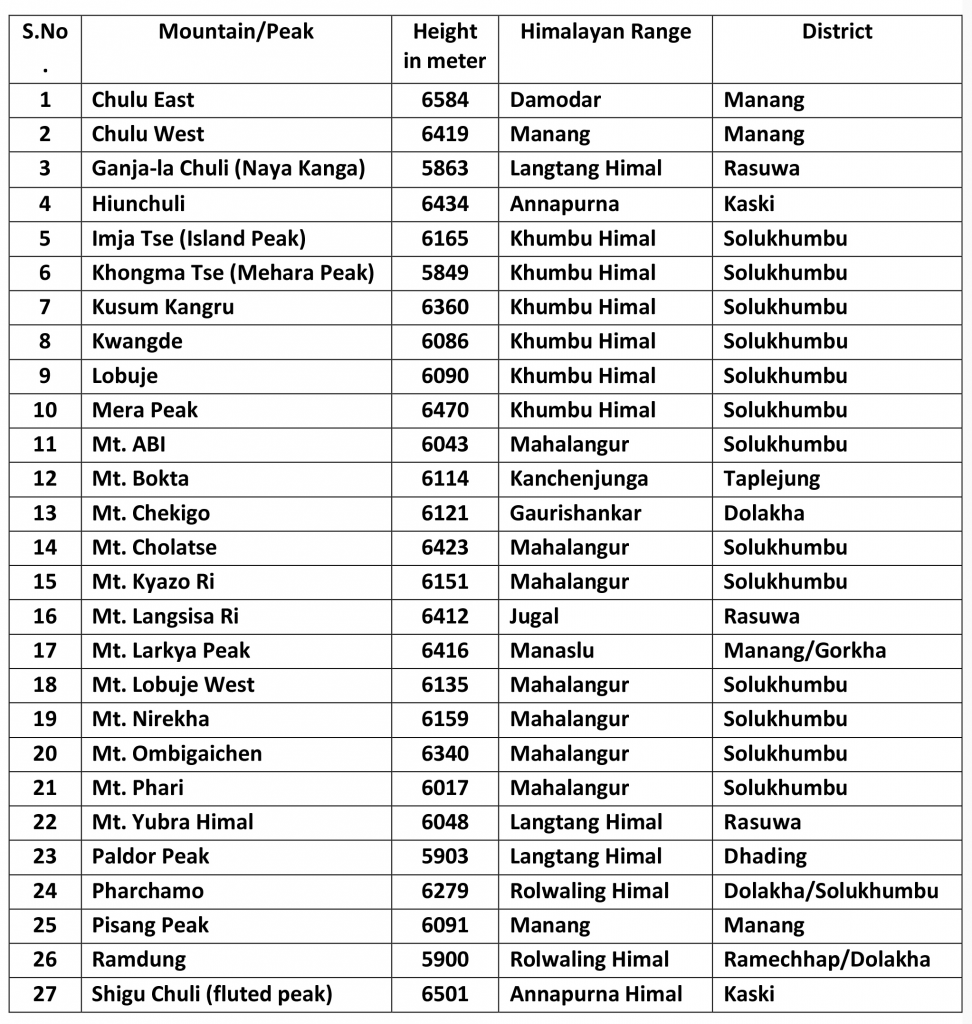 The Nepal Weekly
The Nepal Weekly  September 24, 2024
September 24, 2024
Himalayan peaks of Nepal are famous all over the world. Among the top 14 peaks above 8000m in the world, there are 8 in Nepal. Everest, Kanchenjunga, Lhotse, Makalu, Cho Oyu, Dhaulagiri, Manaslu, Annapurna which are all over 8,000 m above sea level are in Nepal. These mountain peaks attract climbing enthusiasts from around the world.
Thus, the country offers mountain climbing, trekking and hiking opportunities. The mountain region of Nepal has unbelievable land topography and unique combination of flora and fauna. In addition to this, the mountain region has spectacular culture and traditions. The highland ethnic villages provide us with the taste of a unique way of Nepali living.
For novice climbers, it is suggested that test with easy mountains and if the climber bears some previous climbing experience, test with a technical one as well. If it is matter of interest over any of such mountains, a list is given below for such enthusiasts to choice. Moreover, it gives mountaineering pleasure, and more than trekking as such.
The mountains above 6500m and below 7000m are just perfect for your climbing preparation for any 8000m above peaks. Some of these mountains are very easy to climb but some are challenging to climb. Some other mountains are technical as well.
The mountains above 6501m to 7000m are categorised as the adventurous peaks. If climbers want to attempt any of these mountains, he or she needs to obtain a climbing permit from the Ministry of Culture, Tourism and Civil Aviation, Department of Tourism and from Nepal Mountaineering Association (NMA).

Nepal Mountaineering Association is responsible for mountains that are known as Trekking Peaks. These peaks range in altitude from 5,800 m to 6,584 m. Expeditions to peaks below 5800m do not require climbing permits although they will require other forms of permits to enter specific regions.
The best time for mountaineering expeditions is pre- monsoon when the weather is better, especially at altitude, although the visibility might be restricted with the pending monsoon conditions. Autumn is good for the slightly lower peaks, while winter is cold with short days and early spring might be subjected to seasonal snow storms. However, in these times of global warming and climate change, the seasons are no longer as predictable as they used to be.
The NMA is responsible for administering climbing permits for 27 mountains with altitudes between 5,800 metres and 6,600 metres categorised as trekking peaks, while permits for all other mountains open for climbing in Nepal (approximately 300 peaks) are issued by the Ministry of Culture, Tourism and Civil Aviation (MoTCA).

The price of a climbing permit in Nepal depends on the climbed peak. One of the main activities distinguishing Nepal as the extreme in high-elevation mountain climbing without a substitute is extreme adventure climbing. Nepal has about 1300 snow-capped summits, with 8 out of 14 at the highest elevation above 8000 meters, attracting climbing enthusiasts worldwide.

The price of a climbing permit in Nepal depends on the climbed peak. One of the main activities distinguishing Nepal as the extreme in high-elevation mountain climbing without a substitute is extreme adventure climbing. Nepal has about 1300 snow-capped summits, with 8 out of 14 at the highest elevation above 8000 meters, attracting climbing enthusiasts worldwide.
NMA website helps know the royalty fees, which are now $250 for the spring March-April-May season, $125 for the autumn/fall September-October-November season and $70 for the June-July-August monsoon season and the December-January-February winter season. The exception are the two peaks officially over 6500m, which are $400, $200 and $100 for the various seasons.
The above permits can be obtained in a day through a local trekking company. There is now also a refundable $500 garbage deposit for each trekking peak expedition the trekking company has to insure the staff, so they will add a fee for this.
Notably, a significant part of the money collected by the NMA goes to the Nepal Government. (By Ram Dangol)

